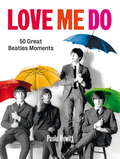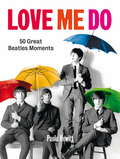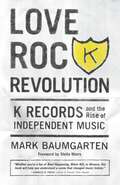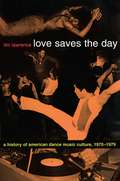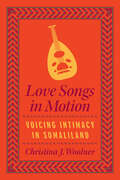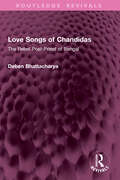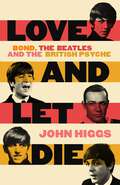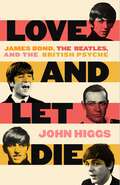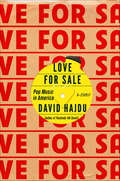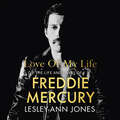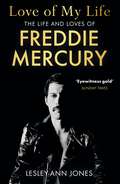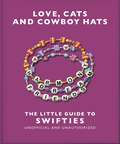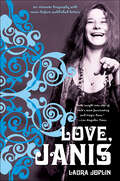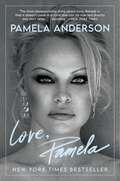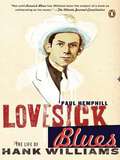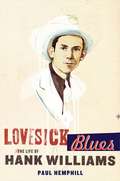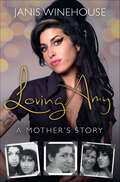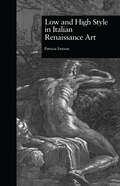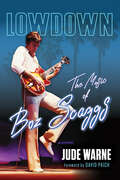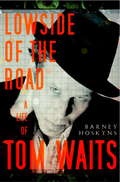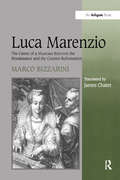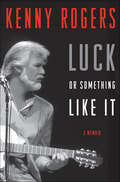- Table View
- List View
Love Me Do
by Paolo HewittLove Me Do tells the story of the Beatles by highlighting and then examining in detail fifty significant events in their amazing career. Using huge amounts of research and personal insight, respected music journalist and author Paolo Hewitt will take the reader on a roller coaster ride, from the band's early days in Liverpool, their raucous behavior in Hamburg, their famous stint at The Cavern, onto the birth of Beatlemania and the incredible worldwide phenomenon that The Beatles became. The effect of worldwide fame on the band was highly significant. It forced them into the studio where they recorded classic albums such as Sgt Pepper and The Beatles. This book will look at their incredible music and their activities outside of that music. We will meet the Maharishi and go shopping with the band on the Kings Road. As the story unfolds we will witness how their ideals and their interests all served to influence their generation and many others. We will also take in the band's reformation in 1996 when Paul McCartney, George Harrison and Ringo Starr recorded and released two of John Lennon's songs. Here, then, are the 50 Great Beatles Moments.
Love Me Do: 50 Great Beatles Moments
by Paolo HewittLove Me Do tells the story of the Beatles by highlighting and then examining in detail fifty significant events in their amazing career. Taking a completely new approach to the band, Paolo Hewitt creates one of the great Beatle biographies in time for the 50th anniversary of the release of the band's first single. Using huge amounts of research and personal insight, Paolo Hewitt will take the reader on a rollercoaster ride, from little-known moments such as the Beatles' audition to be Billy Fury's backing band, the band's early recording of 'That'll be the Day' and George Harrison being deported from Hamburg, to more famous moments, such as the band's stint at The Cavern, their 1969 rooftop gig and the making of the Sgt Pepper album. Beginning with the formation of the Beatles in the late 1950s and concluding with the band's reformation in 1996 - when Paul McCartney, George Harrison and Ringo Starr recorded and released two of John Lennon's songs - this book traces how the Beatles influenced their generation and countless others since.
Love Rock Revolution: K Records and the Rise of Independent Music
by Mark BaumgartenPunk isn't a sound--it's an idea! In 1982, K Records released its first cassette and put its own spin on punk's defiant manifesto: You don't need anyone's permission to make music. Thirty years later, the label continues to operate in the underground while rightfully claiming a role as one of the most transformative engines of modern independent music. In its history, K Records has fostered some of independent music's greatest artists, including Beat Happening, Built to Spill, Beck, Modest Mouse, and the Gossip. It has also galvanized the international pop underground, helped create the grunge scene that took over pop culture, and provided a launching pad for the riot grrrl movement that changed the role of women in music forever. Love Rock Revolutiontells the story of how it all happened, recounting the early journeys of K Records founder Calvin Johnson from the punk mecca of London to the hardcore clubs of Washington, D. C. , in the late-'70s, the creation of K Records in the '80s, the label's role in revolutionizing independent music in the '90s, and its struggle to survive that revolution with its integrity intact.
Love Saves the Day: A History of American Dance Music Culture, 1970-1979
by Tim LawrenceOpening with David Mancuso's seminal "Love Saves the Day" Valentine's party, Tim Lawrence tells the definitive story of American dance music culture in the 1970s from its subterranean roots in NoHo and Hell's Kitchen to its gaudy blossoming in midtown Manhattan to its wildfire transmission through America's suburbs and urban hotspots such as Chicago, Boston, San Francisco, Los Angeles, Newark, and Miami. Tales of nocturnal journeys, radical music making, and polymorphous sexuality flow through the arteries of Love Saves the Day like hot liquid vinyl. They are interspersed with a detailed examination of the era's most powerful djs, the venues in which they played, and the records they loved to spin as well as the labels, musicians, vocalists, producers, remixers, party promoters, journalists, and dance crowds that fueled dance music's tireless engine. Love Saves the Day includes material from over three hundred original interviews with the scene's most influential players, including David Mancuso, Nicky Siano, Tom Moulton, Loleatta Holloway, Giorgio Moroder, Francis Grasso, Frankie Knuckles, and Earl Young. It incorporates more than twenty special dj discographies listing the favorite records of the most important spinners of the disco decade and a more general discography cataloging some six hundred releases. Love Saves the Day also contains a unique collection of more than seventy rare photos.
Love Songs in Motion: Voicing Intimacy in Somaliland (Chicago Studies in Ethnomusicology)
by Christina J. WoolnerAn intimate account of everyday life in Somaliland, explored through an ever-evolving musical genre of love songs. At first listen, both music and talk about love are conspicuously absent from Somaliland’s public soundscapes. The lingering effects of war, the contested place of music in Islam, and gendered norms of emotional expression limit opportunities for making music and sharing personal feelings. But while Christina J. Woolner was researching peacebuilding in Somaliland’s capital, Hargeysa, she kept hearing snippets of songs. Almost all of these, she learned, were about love. In these songs, poets, musicians, and singers collaborate to give voice to personal love aspirations and often painful experiences of love-suffering. Once in circulation, the intimate and heartfelt voices of love songs provide rare and deeply therapeutic opportunities for dareen-wadaag (feeling-sharing). In a region of political instability, these songs also work to powerfully unite listeners on the basis of shared vulnerability, transcending social and political divisions and opening space for a different kind of politics. Taking us from 1950s recordings preserved on dusty cassettes to new releases on YouTube and live performances at Somaliland’s first postwar music venue—where the author herself eventually takes the stage—Woolner offers an account of love songs in motion that reveals the capacity of music to connect people and feelings across time and space, creating new possibilities for relating to oneself and others.
Love Songs of Chandidas: The Rebel Poet-Priest of Bengal (Routledge Revivals)
by Deben BhattacharyaFirst published in 1967, Love Songs of Chandidās provides an informative introduction which makes vividly clear the importance of Chandidās to the Indian peasant masses. As the author tells us, the traveller through the Birbhum area of Bengal hears Chandidās everywhere, in the villages, in the fields, on the roads. Night after night, the people gather in the temple courtyards or on the village greens to listen to professional ‘Kirtan’ singers sing his songs of the divine love of Radha and Krishna. The influence of Chandidās on contemporary Bengali literature is equally important, his songs having enriched the work of great poets such as Rabindranath Tagore, Govindadas, and many others. The author also discusses the interesting topic of the Sahaja (‘spontaneity’) movement in Indian faith and literature, as manifested in the songs of Chandidās, and the worship of love-making, divine and human, as an important aspect of this faith. This book will be of interest to students of literature, music, history, cultural studies and South Asian studies.
Love and Let Die: Bond, the Beatles and the British Psyche
by John HiggsThe Beatles are the biggest band there has ever been. James Bond is the single most successful movie character of all time. They are also twins. Dr No, the first Bond film, and 'Love Me Do', the first Beatles record, were both released on the same day - Friday, 5 October 1962. Most countries can only dream of a cultural export becoming a worldwide phenomenon on this scale. For Britain to produce two on the same windy October afternoon is unprecedented.Bond and the Beatles present us with opposing values, visions of Britain and ideas about male identity. LOVE AND LET DIE is the story of a clash between working-class liberation and establishment control, and how it exploded on the global stage. It explains why James Bond hated the Beatles, why Paul McCartney wanted to be Bond and why it was Ringo who won the heart of a Bond Girl in the end.Told over a period of sixty dramatic years, this is an account of how two outsized cultural monsters continue to define our aspirations and fantasies and the future we are building. Looking at these touchstones in this new context will forever change how you see the Beatles, the James Bond films and six decades of British culture.
Love and Let Die: James Bond, The Beatles, and the British Psyche
by John HiggsA deep-dive into the unique connections between the two titans of the British cultural psyche—the Beatles and the Bond films—and what they tell us about class, sexuality, and our aspirations over sixty dramatic years.The Beatles are the biggest band in the history of pop music. James Bond is the single most successful movie character of all time. They are also twins. Dr No, the first Bond film, and Love Me Do, the first Beatles record, were both released on the same day: Friday 5 October 1962. Most countries can only dream of a cultural export becoming a worldwide phenomenon on this scale. For Britain to produce two iconic successes on this level, on the same windy October afternoon, is unprecedented. Bond and the Beatles present us with opposing values, visions of the British culture, and ideas about sexual identity. Love and Let Die is the story of a clash between working class liberation and establishment control, and how it exploded on the global stage. It explains why James Bond hated the Beatles, why Paul McCartney wanted to be Bond, and why it was Ringo who won the heart of a Bond Girl in the end. Told over a period of sixty dramatic years, this is an account of how two outsized cultural phenomena continue to define American aspirations, fantasies, and our ideas about ourselves. Looking at these two touchstones in this new context will forever change how you see the Beatles, the James Bond films, and six decades of cross-Atlantic popular culture.
Love for Sale: Pop Music in America
by David HajduA personal, idiosyncratic history of popular music that also may well be definitive, from the revered music criticFrom the age of song sheets in the late nineteenth-century to the contemporary era of digital streaming, pop music has been our most influential laboratory for social and aesthetic experimentation, changing the world three minutes at a time.In Love for Sale, David Hajdu—one of the most respected critics and music historians of our time—draws on a lifetime of listening, playing, and writing about music to show how pop has done much more than peddle fantasies of love and sex to teenagers. From vaudeville singer Eva Tanguay, the “I Don’t Care Girl” who upended Victorian conceptions of feminine propriety to become one of the biggest stars of her day to the scandal of Blondie playing disco at CBGB, Hajdu presents an incisive and idiosyncratic history of a form that has repeatedly upset social and cultural expectations.Exhaustively researched and rich with fresh insights, Love for Sale is unbound by the usual tropes of pop music history. Hajdu, for instance, gives a star turn to Bessie Smith and the “blues queens” of the 1920s, who brought wildly transgressive sexuality to American audience decades before rock and roll. And there is Jimmie Rodgers, a former blackface minstrel performer, who created country music from the songs of rural white and blacks . . . entwined with the sound of the Swiss yodel. And then there are today’s practitioners of Electronic Dance Music, who Hajdu celebrates for carrying the pop revolution to heretofore unimaginable frontiers. At every turn, Hajdu surprises and challenges readers to think about our most familiar art in unexpected ways.Masterly and impassioned, authoritative and at times deeply personal, Love for Sale is a book of critical history informed by its writer's own unique history as a besotted fan and lifelong student of pop.
Love in Vain: A Vision of Robert Johnson
by Alan GreenbergRobert Johnson was undoubtedly the most outstanding of the Mississippi Delta blues musicians and also one of the first inductees into the Rock and Roll Hall of Fame, but his short life remains steeped in mystery and wrapped in some of the most enduring legends of modern music. Love in Vain is Alan Greenberg&’s remarkable, highly acclaimed, and genre-defying screenplay and is widely considered to be one of the foremost books on Robert Johnson&’s life and legacy and an extraordinary exercise in American mythmaking. Newly revised and complete with extensive historical notes on Johnson&’s life and the culture of the Mississippi Delta and blues music during the 1930s, Love in Vain is at once a classic of music writing and a screenplay whose reputation lies firmly in the realm of great American literature.
Love of My Life: The Life and Loves of Freddie Mercury
by Lesley-Ann JonesThe truth behind Freddie Mercury's complex romantic relationships.WHO - OR WHAT - WAS THE REAL LOVE OF FREDDIE MERCURY'S LIFE?Millions of Queen and screen fans who watched the Oscar-winning film Bohemian Rhapsody believe that Mary Austin, the woman he could never quite let go of, was the love of Freddie Mercury's life. But the truth is infinitely more complicated.Best-selling biographer and music writer Lesley-Ann Jones explores the charismatic frontman's romantic encounters, from his boarding school years in Panchgani, India to his tragic, final, bed-ridden days in his magnificent London mansion. She reveals why none of his love interests ever perfected the art of being Freddie's life partner.In Love of My Life, the author follows him through his obsessions with former shop girl Mary, German actress Barbara Valentin and Irish-born barber boyfriend Jim Hutton. She explores his adoration of globally feted Spanish soprano Montserrat Caballé. She delves into his intimate friendship with Elton John, and probes his imperishable bonds with his fellow band members. She deconstructs his complicated relationship with the 'food of love' - his music - and examines closely his voracious appetite for - what some would call his fatal addiction to - sex. Which of these was the real love of Freddie Mercury's life? Was any of them? Drawing on personal interviews and first-hand encounters, this moving audiobook brings to the fore a host of Freddie's lesser-known loves, weaving them in and out of the passions that consumed him. The result is a mesmerising portrait of a legendary rock star. Love of My Life, published during the year of the 30th anniversary of his death and that would have seen his 75th birthday, is Lesley-Ann's personal and compassionate tribute to an artist she has revered for as long as she has written about music and musicians.(P) 2021 Hodder & Stoughton Limited
Love of My Life: The Life and Loves of Freddie Mercury
by Lesley-Ann JonesWHO - OR WHAT - WAS THE REAL LOVE OF FREDDIE MERCURY'S LIFE?Millions of Queen and screen fans who watched the Oscar-winning film Bohemian Rhapsody believe that Mary Austin, the woman he could never quite let go of, was the love of Freddie Mercury's life. But the truth is infinitely more complicated.Best-selling biographer and music writer Lesley-Ann Jones explores the charismatic frontman's romantic encounters, from his boarding school years in Panchgani, India to his tragic, final, bed-ridden days in his magnificent London mansion. She reveals why none of his love interests ever perfected the art of being Freddie's life partner.In Love of My Life, the author follows him through his obsessions with former shop girl Mary, German actress Barbara Valentin and Irish-born barber boyfriend Jim Hutton. She explores his adoration of globally fêted Spanish soprano Montserrat Caballé. She delves into his intimate friendship with Elton John, and probes his imperishable bonds with his fellow band members. She deconstructs his complicated relationship with the 'food of love' - his music - and examines closely his voracious appetite for - what some would call his fatal addiction to - sex. Which of these was the real love of Freddie Mercury's life? Was any of them? Drawing on personal interviews and first-hand encounters, this moving book brings to the fore a host of Freddie's lesser-known loves, weaving them in and out of the passions that consumed him. The result, a mesmerising portrait of a legendary rock star, is unputdownable. Love of My Life, published during the year of the 30th anniversary of his death and that would have seen his 75th birthday, is Lesley-Ann's personal and compassionate tribute to an artist she has revered for as long as she has written about music and musicians.
Love of My Life: The Life and Loves of Freddie Mercury - THE PERFECT CHRISTMAS GIFT
by Lesley-Ann Jones'EYEWITNESS GOLD' SUNDAY TIMESWHO - OR WHAT - WAS THE REAL LOVE OF FREDDIE MERCURY'S LIFE? THE SENSATIONAL NEW BIOGRPHAY OF QUEEN'S FRONTMAN Millions of Queen and screen fans who watched the Oscar-winning film Bohemian Rhapsody believe that Mary Austin, the woman he could never quite let go of, was the love of Freddie Mercury's life. But the truth is infinitely more complicated.Best-selling biographer and music writer Lesley-Ann Jones explores the charismatic frontman's romantic encounters, from his boarding school years in Panchgani, India to his tragic, final, bed-ridden days in his magnificent London mansion. She reveals why none of his love interests ever perfected the art of being Freddie's life partner.In Love of My Life, the author follows him through his obsessions with former shop girl Mary, German actress Barbara Valentin and Irish-born barber boyfriend Jim Hutton. She explores his adoration of globally fêted Spanish soprano Montserrat Caballé. She delves into his intimate friendship with Elton John, and probes his imperishable bonds with his fellow band members. She deconstructs his complicated relationship with the 'food of love' - his music - and examines closely his voracious appetite for - what some would call his fatal addiction to - sex. Which of these was the real love of Freddie Mercury's life? Was any of them? Drawing on personal interviews and first-hand encounters, this moving book brings to the fore a host of Freddie's lesser-known loves, weaving them in and out of the passions that consumed him. The result, a mesmerising portrait of a legendary rock star, is unputdownable. Love of My Life, published during the year of the 30th anniversary of his death and that would have seen his 75th birthday, is Lesley-Ann's personal and compassionate tribute to an artist she has revered for as long as she has written about music and musicians.
Love, Cats and Cowboy Hats: The Little Guide to Swifties
by Orange Hippo!Swifties have taken the world by storm. As Taylor Swift's profile has grown, as has her legion of fans, and they're now one of the biggest and most influential fanbases in the world. Over 50% of US adults now count themselves as fans of Taylor, so the Swiftieverse is only going to get bigger. With their devoted, loyal and engaged approach to supporting Taylor Swift, Swifties are one-of-a-kind.This is the ultimate guide for Swifties, packed with everything you need to celebrate the woman who turned heartbreak into art, made friendship bracelets a fashion statement and gave us all permission to dance like nobody's watching. Inside, you'll find fun facts even the most dedicated fans might not know, iconic quotes that will have you saying, "so true, bestie" and quizzes to test just how well you know every era, every lyric and every legendary Taylor moment.Taylor Swift has dominated the music industry like no other artist. With 14 Grammy Awards, including multiple Album of the Year wins, she has cemented herself as a generational talent. The Eras Tour shattered records, surpassing $4 billion in revenue and becoming the highest-grossing tour of all time. Over her career, she has released 12 studio albums, sold more than 200 million records worldwide and topped the Billboard Hot 100 over 40 times. With a dedicated fanbase spanning the globe and a billion-dollar empire built on talent, hard work and reinvention, Taylor Swift is truly in a league of her own.Whether you've been a fan since "Tim McGraw" or you're still in your Folklore era, this book is your ultimate backstage pass to all things Taylor. Packed with fun facts, iconic quotes and quizzes to test your Swiftie knowledge, it's time to grab your glitter pens and shake it off - because this book was made for you.
Love, Cats and Cowboy Hats: The Little Guide to Swifties
by Orange Hippo!Swifties have taken the world by storm. As Taylor Swift's profile has grown, as has her legion of fans, and they're now one of the biggest and most influential fanbases in the world. Over 50% of US adults now count themselves as fans of Taylor, so the Swiftieverse is only going to get biiger. With their devoted, loyal and engaged approach to supporting Taylor Swift, Swifties are one-of-a-kind. This is the ultimate guide to the Swiftieverse, with quotes from the fans and Taylor herself, trivia, facts and everything else you need to fully embrace life as a Swiftie. From Taylor's famous cats to the scarf of "All Too Well", this is the companion you need as your head into the Swiftieverse.
Love, Janis
by Laura JoplinA revealing and intimate biography about Janis Joplin, the Queen of Classic Rock, written by her younger sister. Janis Joplin blazed across the sixties music scene, electrifying audiences with her staggering voice and the way she seemed to pour her very soul into her music. By the time her life and artistry were cut tragically short by a heroin overdose, Joplin had become the stuff of rock–and–roll legend. Through the eyes of her family and closest friends , we see Janis as a young girl, already rebelling against injustice, racism, and hypocrisy in society. We follow Janis as she discovers her amazing talents in the Beat hangouts of Venice and North Beach–singing in coffeehouses, shooting speed to enhance her creativity, challenging the norms of straight society. Janis truly came into her own in the fantastic, psychedelic, acid–soaked world of Haight–Asbury. At the height of her fame, Janis's life is a whirlwind of public adoration and hard living. Laura Joplin shows us not only the public Janice who could drink Jim Morrison under the table and bean him with a bottle of booze when he got fresh; she shows us the private Janis, struggling to perfect her art, searching for the balance between love and stardom, battling to overcome her alcohol addiction and heroin use in a world where substance abuse was nearly universal. At the heart of Love, Janis is an astonishing series of letters by Janis herself that have never been previously published. In them she conveys as no one else could the wild ride from awkward small–town teenager to rock–and–roll queen. Love, Janis is the new life of Janis Joplin we have been waiting for–a celebration of the sixties' joyous experimentation and creativity, and a loving, compassionate examination of one of that era's greatest talents.
Love, Pamela: A Memoir
by Pamela AndersonThe actress, activist, and once infamous Playboy Playmate reclaims the narrative of her life in a memoir that defies expectation in both content and approach, blending searing prose with snippets of original poetry.In this honest, layered and unforgettable book that alternates between storytelling and her own poetry, Pamela Anderson breaks the mold of the celebrity memoir while taking back the tale that has been crafted about her.Her blond bombshell image was ubiquitous in the 1990s. Discovered in the stands of a football game, she was immediately rocket launched into fame, becoming Playboy’s favorite cover girl and an emblem of Hollywood glamour and sexuality. But what happens when you lose grip on your own life—and the image the notoriety machine creates for you is not who you really are?Growing up on Vancouver Island, the daughter of young, wild, and unprepared parents, Pamela Anderson’s childhood was not easy, but it allowed her to create her own world—surrounded by nature and imaginary friends. When she overcame her deep shyness and grew into herself, she fell into a life on the cover of magazines, the beaches of Malibu, the sets of movies and talk shows, the arms of rockstars, the coveted scene at the Playboy Mansion. And as her star rose, she found herself tabloid fodder, at the height of an era when paparazzi tactics were bent on capturing a celebrity’s most intimate, and sometimes weakest moments. This is when Pamela Anderson lost control of her own narrative, hurt by the media and fearful of the public’s perception of who she was…and who she wasn’t.Fighting back with a sense of grace, fueled by a love of art and literature, and driven by a devotion to her children and the causes she cares about most, Pamela Anderson has now gone back to the island where she grew up, after a memorable run starring as Roxie in Chicago on Broadway, reclaiming her free spirit but also standing firm as a strong, creative, confident woman.
Lovesick Blues
by Paul HemphillHank Williams is not just one of America's greatest songwriters but also one of the most enigmatic - a raw poet from the rolling pine woods of south Alabama whose anguished lyrics were celebrated from the clamorous roadhouses of the Deep South all the way to Carnegie Hall. It was a wonder that Hiram ('Hank') Williams ever made it to adulthood at all. Unschooled, virtually fatherless, an alcoholic by his early teens and unlucky in love, Hank was destined for a life in the sawmills and the railyards until he began writing about what he saw and felt. His songs ran the gamut - unrequited love, honky-tonking, loneliness - and they played as well in the fighting and dancing clubs spread across the American outback as on television's 'Your Hit Parade'. He was country, but he wasn't, dozens of his titles crossing over to the pop charts in a career that lasted only six years. He died as he had lived: drunk and drugged, alone in the back seat of a Cadillac convertible, an outcast being chauffered through the snow and ice to play a gig on New Year's Day of 1953, gone at the age of twenty-nine. Paul Hemphill, born and raised in Alabama, has written a fascinating interpretative biography of Hank Williams, with the kind of soul and understanding that other books about him have lacked. Whence the pain and despair? Why the booze and pills? Where did his genius come from? How did he know everything he wrote about? These are the questions it seeks to answer.
Lovesick Blues: The Life of Hank Williams
by Paul HemphillBiography of the quintessential country music singer and songwriter
Loving Amy: A Mother's Story
by Janis Winehouse“Amy was one of those rare people who made an impact . . . She was a bundle of emotions, at times adorable and at times unbearable. . . . Amy’s passing did not follow a clear line. It was jumbled, and her life was unfinished—not life’s natural order at all. She left no answers, only questions, and in the years since her death I’ve found myself trying to make sense of the frayed ends of her extraordinary existence.” Arguably the most gifted artist of her generation, Amy Winehouse died tragically young, aged just twenty-seven. With a worldwide fan base and millions of record sales to her name, she should have had the world at her feet. Yet in the years prior to her death, she battled with addiction and was frequently the subject of lurid tabloid headlines.Amy’s mother, Janis, knew her in a way that no one else did. In this warm, poignant, and at times heartbreaking memoir, she tells the full story of the daughter she loved so much. As the world watched the rise of a superstar, then the free fall of an addict to her tragic death, Janis simply saw her Amy: the daughter she’d given birth to, the girl she’d raised and stood by despite her unruly behavior, the girl whose body she was forced to identify two days after her death—and the girl she’s grieved for every day since. Including rare photographs and extracts from Amy’s childhood journals, Loving Amy offers a new and intimate perspective on the life and untimely death of a musical icon.
Low and High Style in Italian Renaissance Art (Garland Studies in the Renaissance #8)
by Patricia EmisonFirst published in 1998. Routledge is an imprint of Taylor & Francis, an informa company.
Lowdown: The Music of Boz Scaggs
by Jude Warne David PaichBoz Scaggs has always been a musical artist of complexity. Boz Scaggs founded his connection to music through the blues, but his lasting legacy is one of glamorous and romantic pop songwriting. He possessed a somewhat shy and sensitive demeanor never totally at home in the public eye, yet his claim to several chart-topping singles and albums, particularly the millions-selling and critically acclaimed Silk Degrees (1976), demanded constant exposure. The persona he expressed through his music was laid back, effortlessly cool, sophisticated, stylish, romantically charming, and suave. But the immense success he achieved in his career pointed in part to the driven and determined artist within. Lowdown: The Music of Boz Scaggs examines the uniqueness of these contradictions and Boz Scaggs's sixty-plus-year career and his rich and diverse musical catalogue. Over the decades, Scaggs collaborated with an array of talented heavies, from the Steve Miller Band to the Muscle Shoals Rhythm Section (which included a young Duane Allman) on Boz Scaggs (1969), from the session players on Silk Degrees (1976) who would form the hit band Toto to Donald Fagen and Michael McDonald on the Dukes of September's 2010 Rhythm Revue tour.This first-ever book on Boz is constructed around intensely thorough analysis of his complete discography, and new and exclusive in-depth interviews with a selection of Scaggs's associated colleagues from his vast career.
Lowside of the Road: A Life of Tom Waits
by Barney HoskynsWith his trademark growl, carnival-madman persona, haunting music, and unforgettable lyrics, Tom Waits is one of the most revered and critically acclaimed singer-songwriters alive today. After beginning his career on the margins of the 1970s Los Angeles rock scene, Waits has spent the last thirty years carving out a place for himself among such greats as Bob Dylan and Neil Young. Like them, he is a chameleonic survivor who has achieved long-term success while retaining cult credibility and outsider mystique. But although his songs can seem deeply personal and somewhat autobiographical, fans still know very little about the man himself. Notoriously private, Waits has consistently and deliberately blurred the line between fact and fiction, public and private personas, until it has become impossible to delineate between truth and self-fabricated legend. Lowside of the Roadis the first serious biography to cut through the myths and make sense of the life and career of this beloved icon. Barney Hoskyns has gained unprecedented access to Waits’s inner circle and also draws on interviews he has done with Waits over the years. Spanning his extraordinary forty-year career fromClosing TimetoOrphans, from his perilous “jazzbo” years in 1970s LA to such shape-shifting albums asSwordfishtrombonesandRain Dogsto the Grammy Award winners of recent years, this definitive biography charts Waits’s life and art step by step, album by album. Barney Hoskyns has written a rock biography—much like the subject himself—unlike any other. It is a unique take on one of rock’s great enigmas.
Luca Marenzio: The Career of a Musician Between the Renaissance and the Counter-Reformation
by Marco BizzariniRegarded by his contemporaries as the leading madrigal composer of his time, Luca Marenzio was an important figure in sixteenth-century Italian music, and also highly esteemed in England, Flanders and Poland. This English translation of Marco Bizzarini's study of the life and work of Marenzio provides valuable insights into the composer's influence and place in history, and features an extensive, up-to-date bibliography and the first published list of archival sources containing references to Marenzio. Women play a decisive role as dedicatees of Marenzio's madrigals and in influencing the way in which they were performed. Bizzarini examines in detail the influence of both female and male patrons and performers on Marenzio's music and career, including his connections with the confraternity of SS Trinit nd other institutions. Dedications were also a political tool, as the book reveals. Many of Marenzio's dedications were made at the request of his employer Cardinal d'Este who wanted to please his French allies. Bizzarini examines these extra-musical dimensions to Marenzio's work and discusses the composer's new musical directions under the more austere administration of Pope Clement VIII.
Luck or Something Like It: A Memoir
by Kenny RogersA living legend of Country Music and a worldwide music icon, superstar Kenny Rogers has enjoyed a fascinating five decades in show business, and he tells the full story of his remarkable life and career in Luck or Something Like It. From his days with hit group The First Edition to his sterling solo work, the artist who "knows when to hold 'em and knows when to fold 'em" knows how to tell a captivating life story as well–bringing a golden era of Country Music to life as he recounts his remarkable rise to the top of the charts. An honest, moving, eye-opening view of a musician's life on the road, Luck or Something Like It is the definitive music memoir–a backstage pass to fifty years of performing and recording presented by the one and only Kenny Rogers, one of the bestselling artists ever.
